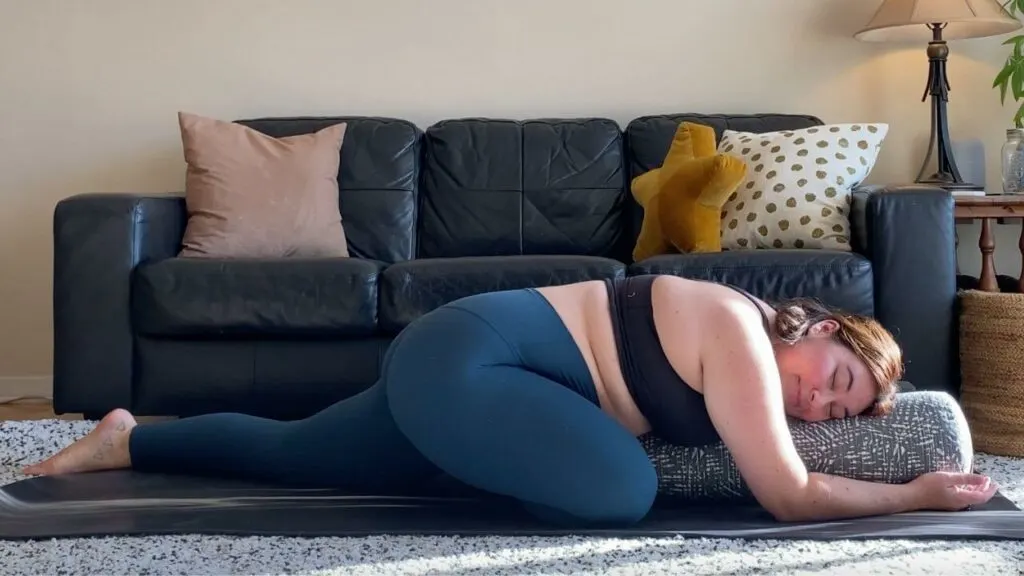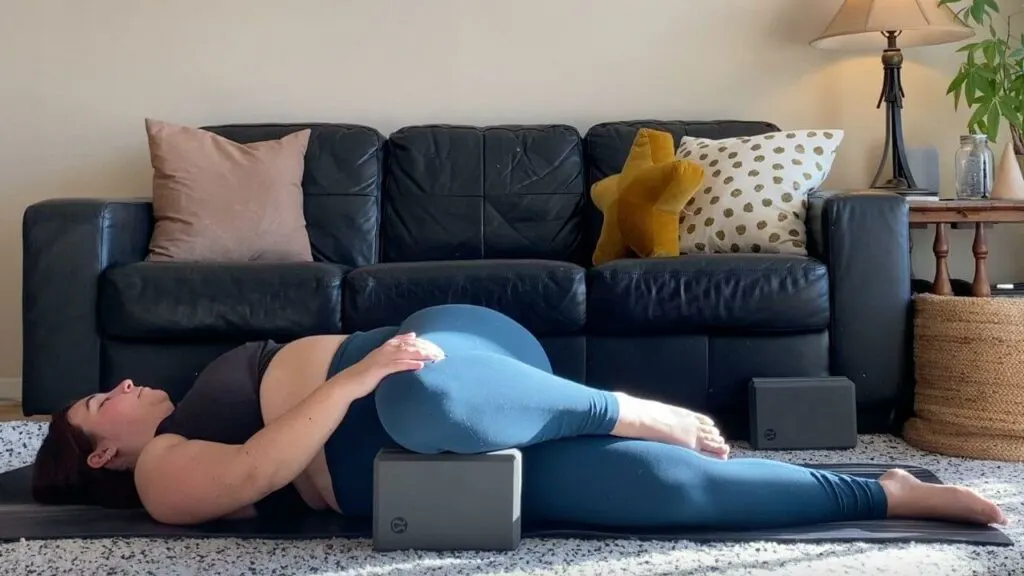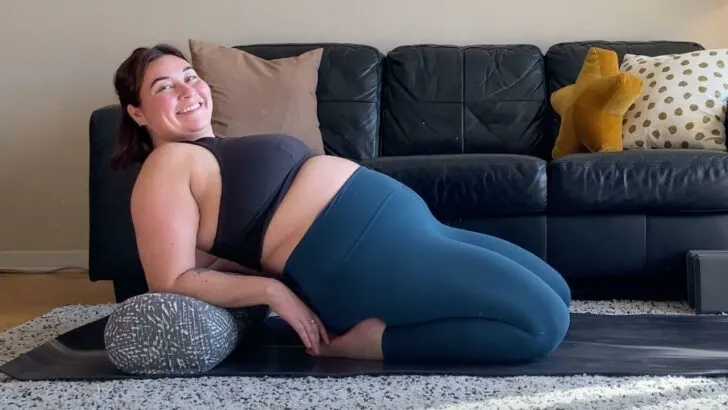If you’ve ever practiced yoga with me in-person or online then you know I am a huge believer in using props. I think they’re even more important in yin yoga because for many you will not reach the true purpose of yin anatomically without the use of a prop.
In yin, it’s important to move away from a holding sensation that works the muscles and instead be able to release and soften so that your joints get the healthy stress that they need. This huge benefit of yin is most easily done through the use of various props.
Why use props in yin yoga?
- To lessen the intensity of a pose
- To increase the intensity of a pose
- To make a pose more accessible
- To make a pose more comfortable to hold
- To provide support for relaxation
Yoga Bolster

A bolster is my ultimate favorite yoga prop. I love it especially for yin because it’s soft and cushy. Since you’re trying to move into the softer side of yin, the bolster is a wonderful representation of this softness in a prop.
For almost any pose that you can use a block for, you can use a bolster to provide extra coziness and relaxation. A bolster also makes many poses more accessible (such as forward folds) and is ideal for those with back injuries. It provides support for the spine both in length when leaning onto a bolster and by bringing the ground closer to the body using the bolster along the length of the spine.
Why a bolster is useful:
- Provides a soft support
- Helps the body to relax
Poses to use a bolster in:
- Banana
- Butterfly
- Bridge
- Caterpillar
- Child’s
- Deer
- Dragon
- Dragonfly
- Frog
- Melting Heart
- Saddle
- Savasana
- Snail
- Sphinx
- Swan
What to use instead of a bolster:
- Rolled blanket or towel (thicker is better)
- Two-three blocks
- A stiff couch cushion
Yoga Blocks

If you’re ever going to get one yoga prop (other than your mat), let it be two yoga blocks. Cork or foam doesn’t matter, that’s personal preference, so long as you have the support of a prop.
Even though yoga blocks are harder, they do invite in a softness to your practice. Blocks can be placed under your knees for tightness or injury to help soften the intensity of a pose. They can assist in supporting your bones so the muscles release tension, like in reclined butterfly. Sitting on a block is ideal to help tilt forward properly in a forward fold. Most importantly, blocks help to lengthen your body to make poses accessible, like putting blocks under your hands in dragon.
Why blocks useful:
- Lengthen your limbs
- Provide support
- Add height and lift the body
Poses to blocks in:
- Butterfly
- Bridge
- Caterpillar
- Child’s
- Dragon
- Dragonfly
- Happy Baby
- Ragdoll
- Reclined twist
- Saddle
- Savasana
- Sphinx
- Square
- Swan
- Yogi Squat
What to use instead of blocks:
- A bolster in many cases
- Thick books
- Thickly folded blanket or towel
Blanket
Let me be clear about one thing first: you do not need a specific yoga blanket! Any blanket around your house will do. I tend to grab the throw I have on my couch and even use it in my yoga videos on YouTube to demonstrate!
A blanket is most often used for cushioning under the knees, wrists, or back of the head. But yin is a cool practice, so it can also be used as it’s meant to, to drape over yourself to keep warm. A blanket is the most versatile prop you can have on hand. Fold it up thickly and it becomes a block or roll it and now it’s a bolster. Lay it on the ground, then it’s your yoga mat!
Why a blanket is useful:
- Provides cushion against the floor
- Keeps the body from getting to cold
Poses to use a blanket in:
- Any pose that a block or bolster can be used in
What to use instead of a blanket:
- Towel
Yoga Strap
Yoga straps are used less so in yin classes and are more popular in restorative classes. That being said, there are a few poses where a strap comes in handy. The most common is when doing yin for the upper body. Cow face arms can be made more accessible by using a strap to hold onto if your fingers don’t reach.
When practicing yin against a wall, a strap can hold your legs in place when doing a straddle to avoid too much intensity. A strap may also hold your legs in a butterfly position, which is especially useful for joint pain or injuries.
Why a yoga strap is useful:
- Add lengths to the arms
- Holds the body in place
Poses to use a strap in:
- Butterfly
- Cow face arms
- Straddle against a wall
- Reclined figure four variation
What to use instead of a strap:
- In some cases, a towel
- Yoga mat carrying strap
Sandbags
In my own yoga practice, I’ve rarely seen sandbags used but when I have practiced with them they have added so much to my practice. I teach very grounding, supportive and stabilizing practices and a sandbag is the best tool for this.
In a pose such as child’s pose, a sandbag can be placed on your back to add gentle pressure and weight. It can be draped over your thigh in a reclined twist, or added over your hips to help them ground into the mat. A sandbag can also help hold your body in place, by putting it on your shoulder to keep it weighted to the ground, or beside your feet so they don’t slip to the side in banana.
A sandbag is like an assist from a teacher but without the physical touch and can be used for longer.
Why a sandbag is useful:
- Adds weight to assist in the yin principle “hold the pose”
- Creates resistance
- Assists stability
Poses to use a sandbag in:
- Banana
- Child’s
- Reclined butterfly
- Reclined twist
- Savasana (on your belly)
What to use instead of a sandbag:
- Weighted or heavier blanket
- Weight bean bags
What’s next?
- Practice yin yoga with me on YouTube.
- Begin to introduce yin into your practice in my Journey Home 30 day yoga adventure.

